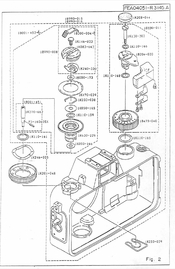beardsofbeards
Member
Like a lot of you here, I’ve recently acquired a cosmetically perfect Nikonos V, but with unknown service history and current water tightness.
I’ve decided I’m going to stand on the shoulders of ki_ and catalog all of the o-rings–both user serviceable and the ones that are supposed to be serviced by now non-existent technicians. I’ll take this a little further than ki_ and use the service manual for inventory of ALL o-rings and label the service manual with actual o-ring dimensions for the good of this community.
I’ll then pressure test the “shell” of the camera with the sensitive electronics removed (in case of flooding) using the testing method Nikon recommends in their service manual (attached). It shouldn’t be very hard—just fill a pressure pot with water, submerge the camera in the water, and pressurize the pot with an air compressor to 5kg/cm^2 as Nikon says to do in their service manual. That’s roughly 5 atmospheres, simulating the 165 feet depth specification of the camera. Should be around 70psi.
I suspect there will be some trial and error testing different o-ring sizes before I get it right.
I’ll record the whole thing—disassembly, measuring of o-rings, reassembly, and testing, and put it up on YouTube as (hopefully) a future tutorial since apparently there’s only 2 guys left performing this service.
These o-rings are insanely cheap. Some of them have to be ordered in minimums of 80 for an entire $2.50. When I finally pass the pressure test, I’ll take the remaining 79 of each type of o-ring I have, pack them up into kits, and put them up on eBay for maybe $10-20 each? Far cheaper than we’re able to find NOS kits for the four user serviceable o-rings that are now likely expired. Nitrile has a 15 year shelf life and with the last cameras produced in 2001 and parts only produced for a few years after that, these NOS kits aren’t going to be too reliable.
I hate to go against a manufacturer’s advice to NOT do this myself, and I hate to cut into the livelihoods of the two techs out there still doing this work, but without this open sourced information, when those two techs retire or stop responding to emails, the community will be left with no option but to try and DIY this to keep this gear running.
This project wont deal with the functioning or CLA-ing of the camera system, there are still plenty of analog camera techs in the world that can help with that. This will just focus on the housing and waterproofing.
I’ve decided I’m going to stand on the shoulders of ki_ and catalog all of the o-rings–both user serviceable and the ones that are supposed to be serviced by now non-existent technicians. I’ll take this a little further than ki_ and use the service manual for inventory of ALL o-rings and label the service manual with actual o-ring dimensions for the good of this community.
I’ll then pressure test the “shell” of the camera with the sensitive electronics removed (in case of flooding) using the testing method Nikon recommends in their service manual (attached). It shouldn’t be very hard—just fill a pressure pot with water, submerge the camera in the water, and pressurize the pot with an air compressor to 5kg/cm^2 as Nikon says to do in their service manual. That’s roughly 5 atmospheres, simulating the 165 feet depth specification of the camera. Should be around 70psi.
I suspect there will be some trial and error testing different o-ring sizes before I get it right.
I’ll record the whole thing—disassembly, measuring of o-rings, reassembly, and testing, and put it up on YouTube as (hopefully) a future tutorial since apparently there’s only 2 guys left performing this service.
These o-rings are insanely cheap. Some of them have to be ordered in minimums of 80 for an entire $2.50. When I finally pass the pressure test, I’ll take the remaining 79 of each type of o-ring I have, pack them up into kits, and put them up on eBay for maybe $10-20 each? Far cheaper than we’re able to find NOS kits for the four user serviceable o-rings that are now likely expired. Nitrile has a 15 year shelf life and with the last cameras produced in 2001 and parts only produced for a few years after that, these NOS kits aren’t going to be too reliable.
I hate to go against a manufacturer’s advice to NOT do this myself, and I hate to cut into the livelihoods of the two techs out there still doing this work, but without this open sourced information, when those two techs retire or stop responding to emails, the community will be left with no option but to try and DIY this to keep this gear running.
This project wont deal with the functioning or CLA-ing of the camera system, there are still plenty of analog camera techs in the world that can help with that. This will just focus on the housing and waterproofing.













